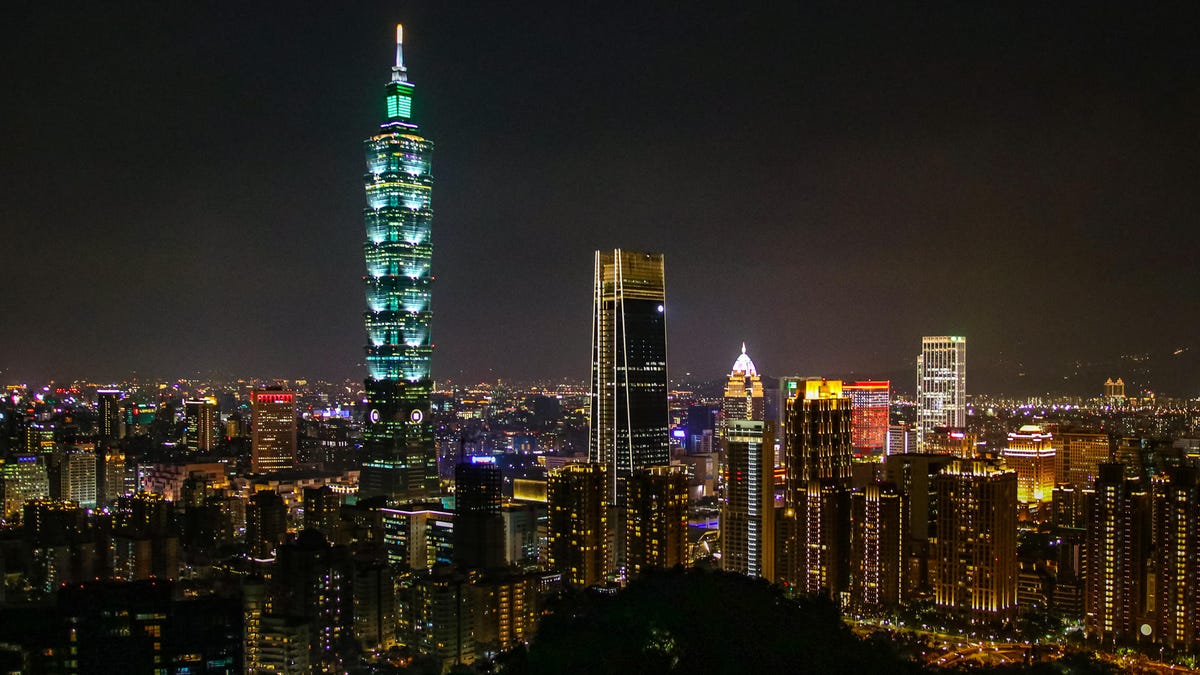 Why You Can Trust CNET
Why You Can Trust CNET Taipei 101: Exploring one of the tallest buildings in the world
Taipei 101 was the tallest building in the world for 6 years. It's still an incredible and unique structure. Here's how it looks up close.

For six years it was the tallest building in the world, and today it stands as an iconic symbol of Taiwan. Not only is it known for its unique design and incredible New Year's Eve fireworks display, the tower is also the world's largest LEED-certified Platinum building -- that's the highest level on the US Green Building Council's Leadership in Energy and Environmental Design scale. It's Taipei 101, and it is one of the most beautiful supertall structures in the world.
There are numerous touches that give the 101 its charm. The stepped design is homage to a traditional pagoda. Water caught by the tops of the eight sections, eight being a lucky number in Chinese culture, is reused throughout the building. The green glass was chosen for a more natural, bamboo-esque look. These two aspects alone make it stand out in a sea of interchangeable bluish-metal and glass skyscrapers all over the world. The discs on each side represent coins. The lights at the top represent a touch. The lighting changes color based on the day of the week.
It is unlike any skyscraper in the world, and regardless of its former status as tallest, it deserves a closer look:
A series of firsts
From when it opened in 2004 until 2010 when it was surpassed by the Burj Khalifa, Taipei 101 was the tallest building in the world. It's currently 10th. The previous title holder was the Petronas Towers in Kuala Lumpur, which as you'd expect has fewer floors (88 total). Perhaps surprisingly, the record holder before that, the Willis (née Sears) Tower in Chicago had far more floors than both: 110. It held the record for 25 years.
But that's not the only records the Taipei 101 held and holds. For 12 years it had the fastest elevator, which may not sound exciting but these moved at over 60 kilometers per hour, or nearly 38 miles per hour.
Still, Taipei 101 holds on to a notable record: It's still the tallest and largest green building, as noted by its aforementioned LEED Platinum certification, the organization's highest honor. It's held that title since 2011.
Oh, and there's one other record it still holds. The largest and heaviest wind damper…
Super Big Wind Damper
One of Taipei 101's coolest features is also one of its unique aspects: a visible tuned mass damper. Most modern tall buildings have one, it's just rare that as a member of the pubic you're able to see it. Even rarer is one as bizarrely gorgeous as this. At 5.5 meters, or 18 feet, in diameter, and 660 metric tonnes, or 728 US tons, it's the largest of its kind in the world.
Taipei 101's tuned mass damper, from my Instagram.
A tuned mass damper is effectively a counterweight: A pendulum, if you will, that's attached, but not rigidly, to the building. When the building sways in one direction, the mass damper takes a moment to follow, effectively minimizing the severity of the sway. When the building sways back the other way, the mass damper, now just catching up to where the building was, is now a drag on the building moving the other way. Mass dampers, usually mounted high in the building, do an amazing job stabilizing tall skinny buildings, especially those in areas known for typhoon winds and earthquakes. You know, like Taiwan.
To give you a better idea how this works, check out the video below. Recorded during a massive typhoon in 2015, the damper is moving up to a meter, or 3.3 feet, setting a record. And remember as you're watching this, it looks like only the damper is moving, but in reality, the building is moving more. The camera is just rigid to the wall. If you were standing there, you'd feel like you were on a boat.
Nǐ hǎo
Taipei 101 may no longer be the tallest building in the world, but it is a gorgeous massive tower in its own right. The city that surrounds it is even more incredible. I spent two weeks exploring Taipei and its environs, and between the incredible and inexpensive food and the delightful and friendly people, I can't wait to go back.
Hiking up Elephant Mountain to get the photo you see at the top… well I won't be doing that again. At least not in August, that's for sure. If you like stairs, and views, and are in better shape than me, go for it.
Taipei 101 is open every day. If you have the time, I recommend arriving about an hour before sunset, and staying until it's dark and seeing the gorgeous city lights. The food court in the basement is pretty solid too, and there's even a Din Tai Fung.
Tickets for adults are NT $600, or about $20 USD, $27 AUD, or £15. If you want, you can book in advance.
As well as covering audio and display tech, Geoff does photo tours of cool museums and locations around the world, including nuclear submarines, aircraft carriers, medieval castles, epic 10,000-mile road trips and more.
Also check out Budget Travel for Dummies, his travel book, and his bestselling sci-fi novel about city-size submarines. You can follow him on Instagram and YouTube.

